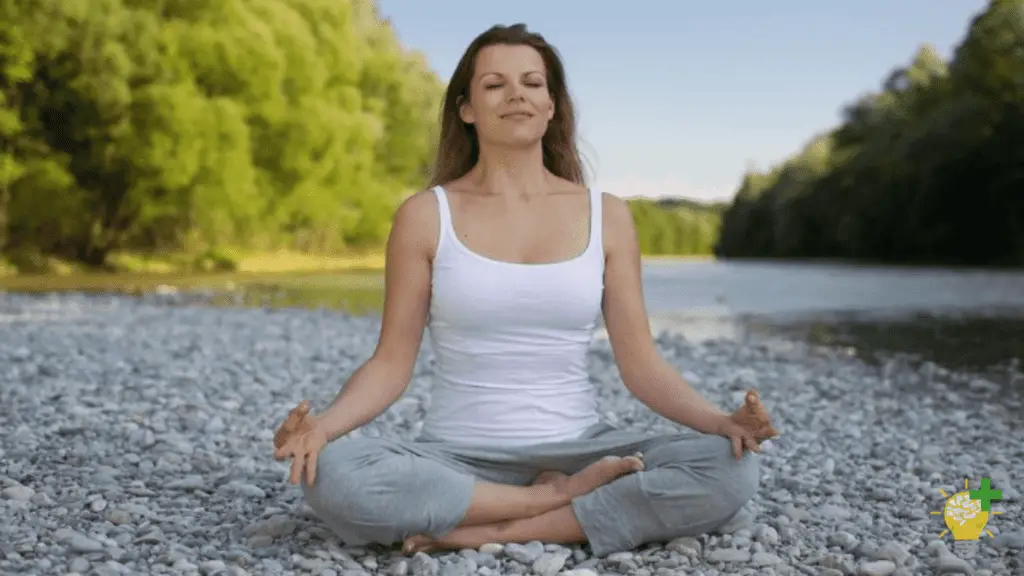Apart from tangible positive effects on your overall well-being, practicing meditation for positive thinking can improve your overall outlook on life.
If you’ve never tried meditation before, this guide will show you the simple steps to get started. All you need is a few minutes each day and a quiet place to sit without being disturbed, where you can focus on positive thought and positive energy.
But before we get into the steps for practicing meditation and how you can use it to improve positive thinking, I’ll like to quickly clarify what meditation is.
What Is Meditation?
For many people, the term meditation calls to mind a stereotypical image that goes something like this: a Tibetan monk clad in a shawl, wearing a long skirt, and sitting in a lotus position with no thoughts running through his mind.
But this picture isn’t necessarily what meditation is about.
In simple terms, meditation is training your attention without judgment. It is the practice of being present and keenly aware of your thoughts and the feelings associated with your pattern of thinking. This includes negative thoughts and negative emotion as well as positive thought and positive emotions.
You don’t have to try to stop your thoughts or “empty your mind” when you meditate. Is it even possible to have no thoughts? From a scientific point of view, our brains never stop thinking. We simply can’t turn off our thoughts unless, of course, we are dead.
There are different practices of meditation and positive psychology, depending on spiritual traditions and cultures. Some of the more popular practices include:
- Mindfulness meditation
- Visualization meditation
- Progressive relaxation
- Movement meditation
- Transcendental meditation
- Loving-kindness meditation
- Focused meditation
- Mantra meditation
- Spiritual meditation
Regardless of the specific type of practice, mediation generally offers plenty of benefits, such as better sleep, reduced aggression, and reduced stress. Consistently practicing meditation can also lead to a healthier aging process and lower blood pressure.
However, the goal of this article is to help you use meditation to improve your positive thinking skills. To do this, focused meditation – focusing on your breath – is an excellent option.
Steps to Practice Meditation for Positive Thinking
Here are the simple steps to practice meditation. You don’t need any special tools for this activity. It only requires deliberately bringing your attention to the present by focusing first on your breath and then gradually shifting your focus to your thought processes.
Take Care of a Few Practicalities Before You Start
Meditation is not a one-time event – not if you want any meaningful impact from the practice. For this reason, you need to commit to making it a daily practice. That means you must prepare to integrate the practice into your daily routine.
To do this, here are some of the practicalities you need to consider:
- What time will it be most convenient for you to meditate? Some people do it early in the morning before their day gets busy, while others do it right before bedtime. Still, some people practice meditation more than once a day. Whatever time works for you, it is important to stick to that time so that the practice can easily become a habit.
- Where can you sit for about 5 to 10 minutes undisturbed? Decide in advance the likely quiet spots at home or in the workplace (during breaks) where you can practice meditation without anyone bothering you. Don’t wait until it is time to meditate before looking for a good place to quiet your mind.
- How do you plan to remind yourself to meditate daily? You can set a timer on your mobile phone since you’re most likely to carry it almost everywhere. Alternatively, you might want to use a meditation trigger – an event that happens daily – to remind yourself about the practice. You might need to experiment with a few different triggers to identify what works best for you.
- What would you be wearing? There is no hard and fast rule here. No. You don’t have to dress like a monk! Just make sure to wear comfortable clothing, perhaps loosen your belt or any ties. Consider taking off high heels or tight footwear.
Step 1: Settle In and Relax

At the set time, make sure you are comfortable and go to your quiet place. Sit in a chair, and relax. And yes, it is perfectly fine to sit on a chair. Usually, a chair with an upright back is an excellent choice, as it will support your back.
If you prefer to sit on the floor, that’s great, too! Consider getting a pillow or cushion to support your lower back.
Some people meditate while lying flat on their backs. This posture is okay and is particularly good if you experience discomfort when sitting.
Lying down is also great when you want to do a mindfulness body scan.
However, if you want to practice meditation for positive thinking, sitting offers the most advantageous position, helping you strike a balance between relaxation and focus.
If you are like most newbie practitioners, there is a high chance you’ll drift off to sleep if you try to meditate while lying down. That’s because lying down allows you to feel a bit too relaxed.
When you sit in your chair:
- Set your timer for your preferred duration (5 to 10 minutes is okay for a start).
- Rest your hands on your knees, lap, or the chair’s arm while keeping your back straight.
- Relax your neck and slightly tuck in your chin.
- Avoid unnecessary movements and commit to completing the session, regardless of whether you think it is difficult or easy.
Step 2: Take Deep Breaths
Slow, deep breaths anchor you to the peace in the present moment. This allows you to let go of depressions rooted in the past and anxieties about the future.
There are several breathing techniques when it comes to meditation for positive thinking. But to keep things simple, here’s one method I suggest:
- Fix your gaze softly at a point directly in front of you (a small spot on the wall is fine).
- Take a slow, deep breath in and exhale slowly.
- Repeat this five times.
- Gently let your eyes close on the fifth exhalation.
Fixing your gaze on one spot helps you defocus your eyes, and closing them afterward reduces the chances of distractions that may happen when you see something in your environment.
Step 3: Settle Into Your Body
With your eyes closed, it is time to acknowledge your senses and settle into your body. Gently bring your attention to the sensations in your body, particularly in areas where your body parts are in contact with the chair and the ground.
Notice the weight of your hands and arms resting on the laps or the hand of the chair. Acknowledge any sounds you can hear, smell you perceive, or the sensations of heat or wind blowing on your skin.
Step 4: Scan Your Body
If you’re like most people, you probably ask others, “How are you?” quite often. Unfortunately, not many of us ask ourselves that same question.
This step is a good way to ask your body, “How are you?”
Here’s how:
- Gently turn your attention inward.
- Take about 20 seconds to scan your entire body by focusing on your head and slowly moving down to your toe.
- Notice if you feel discomfort or tension anywhere, but don’t do anything to change what you feel.
- Scan your body again for about 20 seconds. This time, observe where you feel relaxation. Again, simply observe but don’t try to change anything about your feeling.
Step 5: Become Aware of Your Thoughts and Underlying Moods
The rest of the steps are where positive thinking meditation really kicks in. Once you are settled into your body, it is time to observe your thoughts in a non-judgmental way.
In other words, you are an outside observer of your thoughts, so you don’t get roped in by them. Simply allow each thought to pass without trying to alter them or feeling any attachment to them. Avoid negative thinking and continue breathing.
Here’s what to do:
- Bring your awareness to your thoughts and observe what’s going through your mind without altering anything.
- Become aware of your moods without judgment.
- Simply observe whatever comes up and let it pass like the clouds in the sky.
- Spend about 30 seconds doing this.
- Now, take a few moments to remind yourself that there is nothing for you to do except simply sit and observe. Recognize any desires or expectations you bring to your meditation session and let them go.
Step 6: Focus on Your Breath
Your mind will wander during meditation – that’s a given. But don’t be hard on yourself when this happens. When you observe that you have wandered off in thought, simply bring your awareness to your breath.
Step 7: Open Your Eyes When You Are Ready
Sit for a few more minutes doing absolutely nothing except breathe after this guided meditation. Continue this until your timer goes off.
Gently open your eyes when you are ready, noting if there has been any shift in your awareness following your positive thinking meditation.
Now, go about the rest of your day with a sense of connectedness to your inner power!




